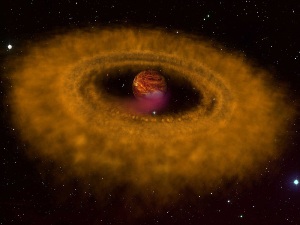Oct 11 2013
Astronomers including Niall Deacon of the Max Planck Institute for Astronomy (MPIA) captured an image of an unusual free-floating planet. As the object has no host star, it can be observed and examined much easier than planets orbiting stars, promising insight into the details of planetary atmospheres.
Can an object with as low a mass as this have formed directly, in the same way that stars form? Independent observations by a group led by MPIA's Viki Joergens suggest that this is the case: They discovered that a similar but much younger free-floating object is drawing material from its surrounding just like a young star.
 Solitary object II: The object OTS44 seems to have formed in a similar manner than a star. Even now, there is still gas falling onto OTS44 from the disk that surrounds it. © A. M. Quetz
Solitary object II: The object OTS44 seems to have formed in a similar manner than a star. Even now, there is still gas falling onto OTS44 from the disk that surrounds it. © A. M. Quetz
Things used to be so simple. On the one hand, there were stars: gigantic incandescent nuclear furnaces, emitting substantial amounts of light. On the other hand, there were planets, with much lower masses than stars, reflecting their host stars’ light. Stars formed from the collapse of gigantic clouds of gas; planets formed in disks of gas and dust around their nascent host stars. In between there was the somewhat more ambiguous class of brown dwarfs: an intermediaries between planet and star, more massive than a planet, but with insufficient mass for nuclear fusion to ignite in the object’s core, turning it into a star. Now, two new discoveries have blurred the border between these kinds of object even further, as they show that free-floating objects with planet-like masses very likely form like stars.
Using the Pan-STARRS 1 (PS1) telescope on Hawai’i, an international team of astronomers led by Michael Liu from the University of Hawaii has discovered an exotic young object with a mass six times that of the gas giant Jupiter, which is floating in space on its own – no host star in sight. The object, dubbed PSO J318.5-22, is located just 80 light-years away from Earth, in the constellation Capricornus. Its properties are similar to those of giant gas planets found orbiting around young stars. At an estimated age of 12 million years, it is an adolescent in terms of planetary or stellar ages.
Between 1995 and now, astronomers have found nearly a thousand extrasolar planets – but mostly by indirect methods, detecting a wobbling or dimming of the host stars induced by the planet. Only a handful of planets have been directly imaged, all of which are around young stars (less than 200 million years old). PSO J318.5-22 is very similar in mass, colour, and energy output to those directly imaged planets.
Niall Deacon (Max Planck Institute for Astronomy), who is a co-author of the study, explains why this is a stroke of luck for astronomers: “Planets found by direct imaging are incredibly hard to study, since they are right next to their much brighter host stars. PSO J318.5-22 is not orbiting a star so it will be much easier for us to study. It is going to provide a wonderful view into the inner workings of gas-giant planets like Jupiter in an early phase of their evolution.”
With just six times the mass of Jupiter, PSO J318.5-22 is one of the lowest-mass free-floating objects known, perhaps the very lowest. Ordinary planets are formed in a disk of gas and dust surrounding the embryo of the star they will eventually orbit. But how do solitary objects like this come into existence? Can objects this low-mass - free-floating planets and brown dwarfs in general – form in the same way as ordinary stars? An in-depth study of a different object, published at the same time by another group of astronomers which is led by MPIA’s Viki Joergens, provides valuable evidence that they do.